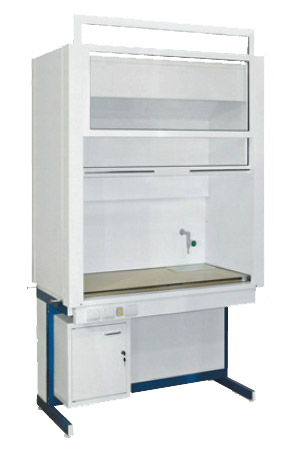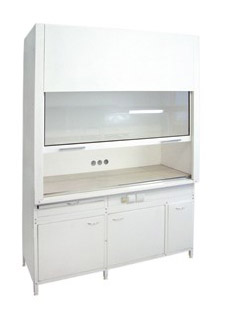- Home
- >
- Products
- >
- Analyzers of protein, fat, fiber and moisture concentration
- >
- Laboratory hood
Laboratory hood
Modular universal laboratory hoods
 Laboratory hood is the main tool to protect respiratory passages of laboratory technicians. These hoods should be used when working with hazardous substances in chemical laboratories.
Laboratory hood is the main tool to protect respiratory passages of laboratory technicians. These hoods should be used when working with hazardous substances in chemical laboratories.
Laboratory hoods are made of steel sheet and steel profile, and coated with chemically resistant powder paint based on epoxy resins.
In order to increase the safety of experiments, a triplex is used as a protective shield.
Modular universal laboratory hood is all-metal box with a vertical screen and metal side walls. The screen is a triplex located in aluminium frames, with a system of counterweights. Counterweights are located on the back of the hood. Screen lifting height is 800 mm. The exhaust chamber is made of cold-rolled metal sheet painted with epoxy resin powder paint. Air exhaust is made in the chamber consisting of two zones (light and heavy gases). At the bottom of laboratory hood there is a dismountable reinforced frame from a profile pipe of rectangular section 60x30 mm. The hood is equipped with 200 mm diameter flange for connection to exhaust system. Height with raised screen is 2,500 mm.
Laboratory hood electrical equipment:
- Junction box for power supply to the hood, it is located on the back of the exhaust hood.
- LED lamp placed in a dust and moisture resistant housing, it complies with ingress protection class of IP65. It is located in the upper part of the exhaust hood (regardless of aggressive media); it lights the working surface of the chamber.
- Two circuit breakers.
- Two drop-proof sockets with grounding.
- LED lamp switch.
The maximum power of connected electrical equipment is 3.5 kW.
Also, the laboratory hood shall be equipped with flexible tubes, drainage system, drain sink, TOF water tap (Italy) with a chemical-resistant coating mounted on the back wall of the exhaust chamber.
Drain sink is made from:
- polypropylene for KS-12 ceramic worktops;
- Durcon epoxy composite for Durcon worktops;
- monolithic ceramics for worktops made of monolithic ceramics.
|
Width, mm |
Depth, mm |
Height (with turned up screen), mm |
Gross weight, kg |
Net weight, kg |
|
1000 |
750 |
2600 |
212 |
183 |
|
1300 |
750 |
2600 |
250 |
216 |
|
1600 |
750 |
2600 |
293 |
255 |
|
1900 |
750 |
2600 |
345 |
300 |
Additional equipment for laboratory hoods
- Explosion-proof design: special sealed light and switch, bulletproof glass, armored electrical cable.
- Electronic control system and air flow control.
- Valves for vacuum, gases, compressed air.
- Waste discharge system with overflow sensor.
- Explosion-proof lamp.
- MKVP-02 airflow monitor-controller.
- Ceramic drain sink instead of polypropylene one, plastic and ceramic KS-12 worktops.
- Tap and flexible tubes for supply of gas, water, vacuum, compressed air.
- Remote control from hood front panel with a tap for water (gas, vacuum, air).
- Stand mesh on the back wall.
- Fiberglass crown.
- Rubber gloves mounted on the screen.
- Retractable removable trays for reagents in the hood base (2 pcs.).
- Drawers for storing reagents.
- Plastic tray for reagents in the hood base for reagents 400x260x60 mm.
- Plastic coating of the hood base for reagents.
- Optional splash-proof electrical sockets on the front panel.
Laboratory hood, economy design (Ceramics KS-12)
Worktop effective width
- 900 mm
- 1200 mm
- 1500 mm
- 1800 mm
Laboratory hood, standard design (Durcon with toe plate)
Worktop effective width
- 900 mm
- 1200 mm
- 1500 mm
- 1800 mm

Laboratory hood, chemically resistant design
To work with concentrated alkalis and acids, as well as their vapours at high temperatures (boiling in acids / alkalis, evaporating acids), laboratory hoods with a fiberglass crown are manufactured.
In tests, fiberglass withstood all types of concentrated alkalis and acids without staining, as well as heating to +200 °C (polypropylene and PVC panels, in turn, lost their shape and properties when heated above 70-80 °C). The fiberglass crown is a one-piece product without joints and seams.
If necessary, it is possible to cover the hood base with plastic for storing alkali and acid.
When working with HF hydrofluoric acid, the laboratory hood shall be equipped with a Lexan polycarbonate screen, as triplex becomes cloudy when exposed to hydrofluoric acid.
Chemically resistant laboratory hood (monolithic ceramic with toe plate + fiberglass crown)
Worktop effective width
- 1200 mm
- 1500 mm
- 1800 mm
